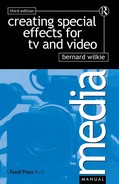Model Landscapes
Model landscapes for TV purposes are usually built on a firm baseboard with a hardboard backing on which the sky is painted. For movie productions (where the definition must be greater) miniature landscapes are often far from ‘miniature’, occasionally filling entire studios.
Constructed of materials such as wood, card, plaster, expanded polystyrene and so on, landscapes seldom need to be built with any degree of permanence. Sand heaped on to the base-board and sprinkled with coloured sawdust will resemble rolling hills and is easier to modify than a solid construction of plaster or sculptured polystyrene.
Fields and trees
For conventional terrestrial scenes, trees, bushes and other forms of vegetation can be created from a variety of natural and man-made materials. Most popular is lichen moss, which can be dyed and used to simulate small bushes and hedges. Fastened to wire stalks it can look like miniature deciduous trees.
Conifers can be reproduced by cutting and shaping laboratory bottle brushes and, after a spray of adhesive, dipping them in dyed sawdust.
Small pieces of torn sponge or plastic foam can be painted to resemble vegetation, but some of the most convincing mini-plants and bushes can be obtained from dried weeds and wild flowers.
Dyed sawdust is used for ground treatments where it resembles ploughed earth or verdant fields. A variety of greens, ochres, yellows, browns and black should be used and the different colours scattered one upon another in variations.
Perspective
To resemble its full-size counterpart a landscape model should be built with a certain amount of false perspective. Roads should be wide near the lens and narrow towards the horizon. Fields should be compressed as they recede.
Matte lines
The division between a miniature and the real scene is, of course, in full view. It is therefore necessary to create a join in which it passes unnoticed. A sharp line such as the top of a wall or the side of a building can provide a good merging point, but where gardens or rugged landscapes are involved it is possible to camouflage the join by affixing small pieces of lichen moss or other materials to the front of the miniature’s base-board.

Model trees can be made by twisting brush hairs in a loop of wire. This is best done with a hand-dfill and a fixed anchor point such as a nail.
The simplest shape to make is the conifer, but many other varieties can be obtained by cutting and shaping the hairs with nail scissors.
Sprayed with glue and dipped in coloured sawdust, these tiny trees can look extremely lifelike
